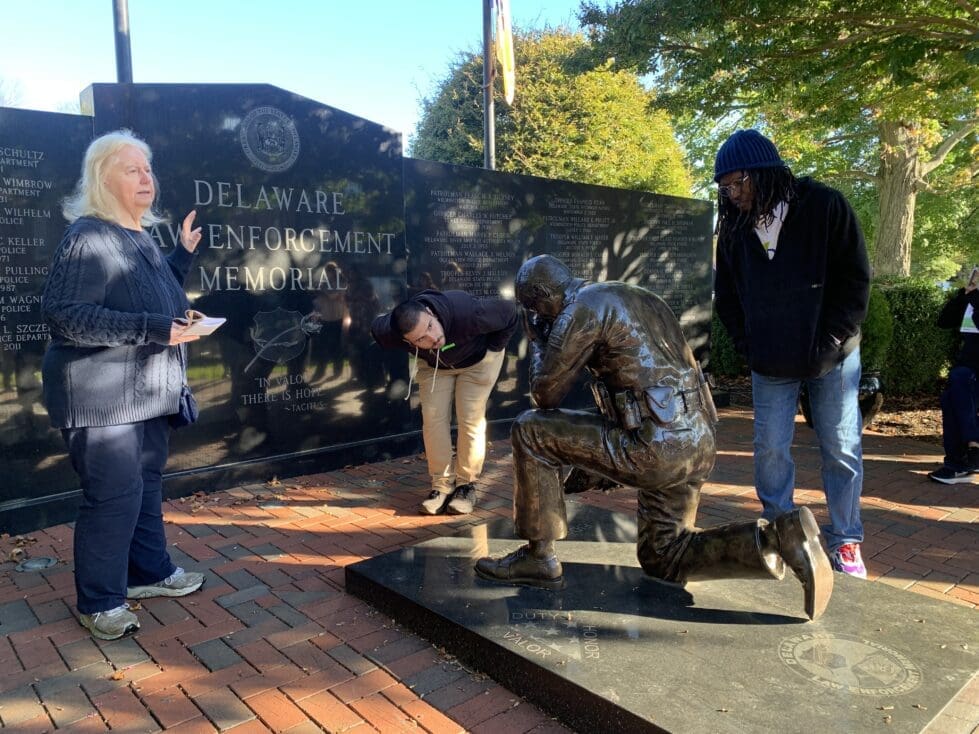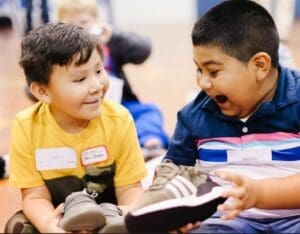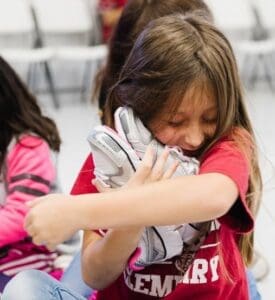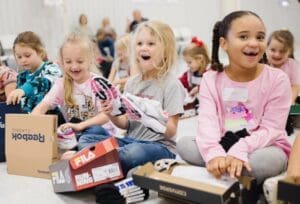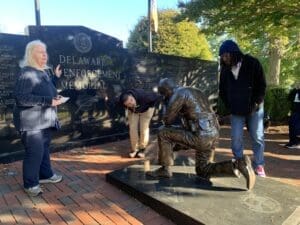
Dr, Chandra Reedy, left, led a group of Dover students on a bus tour of that city’s public art as part of a Delaware Institute for the Arts In Education program.
A busload of Dover students last year were treated to a tour of public art as experts talked about the thought processes behind choosing designs to fit those memorials and displays.
A Wilmington mom helps 2,000 low-income and homeless children receive name-brand athletic shoes each year so they could better participate in school activities.
And the Food Bank of Delaware staff and volunteers next week will assemble hundreds of weekend meal kits to combat children’s food insecurity in Kent and Sussex County.
All three of the nonprofits behind those feats will participate in the 24-hour fundraiser, Do More 24 Delaware, starting Thursday, March 7.
A joint venture by United Way of Delaware and Spur Impact, the event invites the public to donate a bit more to their favorite Delaware nonprofits — or maybe to find a new cause that interests them among the 500-plus participating in this year’s event. It runs from 6 p.m. March 7 to 6 p.m. March 8.
Charles Vincent, executive director of Spur Impact, said his organization’s interest in working with the United Way for Do More 24 morphed out of smaller, focused events it was doing with nonprofits.
“The idea of putting it all into a single day of giving, sort of like a supercharged Delaware Giving Tuesday, is really to emphasize the depth of nonprofit work here in the state,” said Vincent. “It’s trying to raise awareness for all the work that nonprofits are doing as a whole.”
Do More 24’s genesis
After the two groups started looking for the right date to hold Do More, they settled on March, he said.
It’s far enough from Giving Tuesday after Thanksgiving and from the push nonprofits make for year-end support to make it meaningful for both donors and charities, he said.
Delaware has 1,300 active nonprofits, which sounds like a lot for a state of 1 million people. Most other states have a lot more charities per capita, Vincent said.
Nonprofits also are the second largest employment sector in Delaware, behind the state, with an economic impact of $7 billion, he said.
Many people don’t realize the breadth of nonprofits, Vincent said. They typically think of them as a 501(c)(3) with a narrow focus, but don’t realize that big organizations such as the YMCA and Boys and Girls Clubs also are nonprofits.
The public also doesn’t realize how much nonprofits do through contracts with the state to provide services such as child care and afterschool programs so people can work, or care for older people or the homebound so they can remain in their homes, he said.
“It’s really a symbiotic relationship for a lot of those organizations,” he said.
If a group like the Boys and Girls Clubs didn’t exist, a lot of child care programs would disappear.
“The state can’t do everything,” Vincent said.
But even with support like that, most nonprofits are under-resourced and understaffed, and Do More 24 helps by letting them take advantage of collective marketing efforts, he said.
Organizers built in some bonuses for the organizations and their donors. More than 25 sponsors have ponied up cash to match gifts and to create incentives and rewards for things like the largest total of gifts in the first hour, or the largest number of single donors to one cause.
More than 17,000 donors participated last year, donating more than $2 million, with many people giving to multiple groups. People gave donations of all sizes, he said.
The number of donors participating, and the overall amount donated, is rising gradually each year, Vincent said.
Here’s a look at two of the more unusual nonprofits participating in Do More 24.
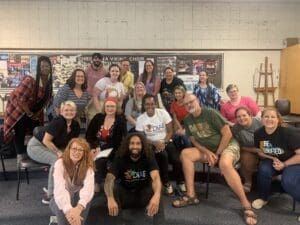
Christina School District music teachers at an Institute professional development program, with, bottom row, artists Jea Street and Ashley SK Davis.
Delaware Institute for Arts in Education
The Institute, founded in 1982, has a team of 15-plus artists that it places in schools to work with teachers on programs tailored to the teachers’ curricula.
“The idea is that the teachers will select a performance or an exhibition that they want their students to see,” said A.T. Moffett, executive director, “and then we backward design with the teacher to create a three-day residency that gets the students ready to experience that production.”
The Institute sent Dr. Chandra Reedy, a historic preservation expert at the University of Delaware, and teaching artist JaQuanne LeRoy Daniels to Dover to work with Dover High School art teacher Mary Jane Long before her students took a tour of the city ‘s public art.
The nonprofit is doing a year-long professional development training program for Christina School District’s visual and performing arts teachers.
“It’s really exciting for us as a team to be able to work closely with and build relationships with the teachers and help develop curricula with new insights and inputs,” Moffett said.
The Institute also offers the child-focused Delaware Wolf Trap Early Learning Through the Arts program that puts artists into the classrooms of Delaware’s 3- to 5-year-old students.
The artist works with a teacher to integrate lessons and activities they can do in their class “because if we know anything about little young learners, it’s that they learn through movement and through songs,” Moffett said.
Not every school has a full-time art or music teacher, Moffett said. Her son’s and daughter’s band teacher works in three schools.
The Institute provided 47 programs last year on its annual budget of $330,000.
Teachers find the Institute through its website, social media and word of mouth from other teachers or arts and culture organizations with which the Institute works, including the Delaware Art Museum, The Delaware Contemporary and the Grand Opera House.
The Institute also has been active in teacher professional development and K-12 residency programs that deal with the state’s new law requiring Black history be included in every subject.
“It’s very interesting in the visual and performing arts where teachers are teaching the same set of curriculums as history, science and math,” Moffett said. “We’re really active in that space.”
Shoes That Fit
Joanne Glauser was eight months pregnant with her daughter in 1998 when she read a Family Circle article about a California mom who started a charity to provide athletic shoes to homeless and children from low-income families.
The article described how single mom Elodie McGuirk founded Shoes That Fit after hearing a story about a boy in her children’s school complaining his feet hurt. When school personnel checked, his shoes were so small, his toes were folding under his foot.
Glauser immediately reached out to McGuirk and offered to create a Delaware chapter.
“Fast forward, and I’m the oldest and only chapter that started back then that’s still active,” said Glauser, who works at Wells Fargo during the day.
In those 26 years, Shoes That Fit Delaware has provided 50,000 pairs of shoes for children, about 2,000 a year.
It does that on a $30,000 budget, created totally from donations.
The way the shoes are provided has changed since she launched the Delaware chapter.
She started out asking for money for shoes she would buy. That was a cumbersome process that required a lot from her and didn’t always give kids quality name-brand shoes.
Now, the national organization has relationships with major brands who provide shoes, which chapters can buy for $30.
It’s a bargain for the quality, Glauser said.
IN THE NEWS: Here’s how Delaware slices its school funding pie
Working with the charity has been uplifting, Glauser said.
A new pair of shoes that fit helps children feel like they belong and participate in the world around them.
“It’s one of the many things that they need to be equals as they come into the school every day and also to start to feel a sense of hope for themselves,” she said.
Shoes That Fit works in all three counties with homeless advocates, school districts and family crisis therapists to get a list of children who need shoes and the sizes they need, laid out on a spreadsheet.
Many times, she said, she has to tell them she can pay for 200 pairs, and she needs the school’s help in deciding who needs the shoes the most.
The 2,000 children she helps a year are only a fraction of what’s really needed, she said, because children rapidly grow through shoes as they age.
She estimates the charity would need $90,000 to be able to provide for most of the children who really need help.
One of the things Glauser hopes to do in coming years is find grants to help pay for more shoes and to find community partners.
She’s happy to accept all donations, but says it would be lovely to have a group who wanted to sponsor 100 children at a specific location for $3,000.
Glauser also is starting to look ahead. She hopes to retire in about 5 years.
“I want to do this in retirement, but I also want to find somebody in each county who would have the same passion to continue with it,” Glauser said, “so it goes on beyond me because it’s a very simple model, and it’s very much needed here and I don’t want to see it die with me.”

Betsy Price is a Wilmington freelance writer who has 40 years of experience, including 15 at The News Journal in Delaware.
Share this Post


